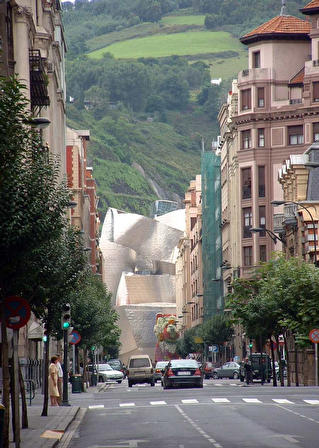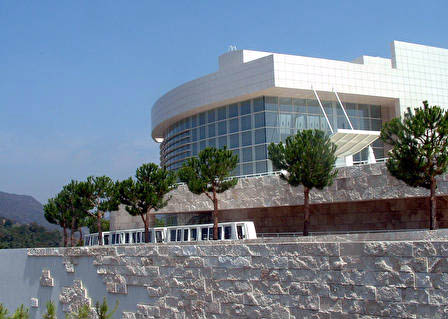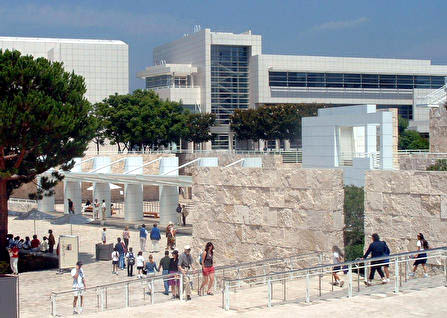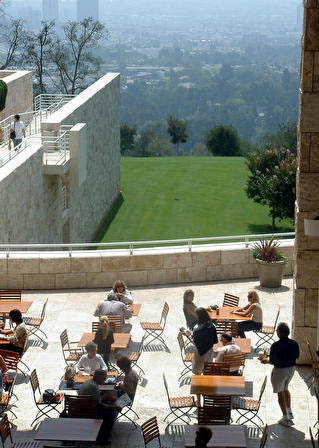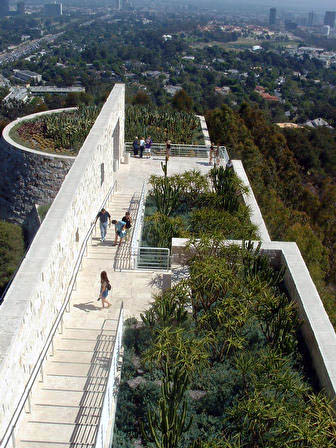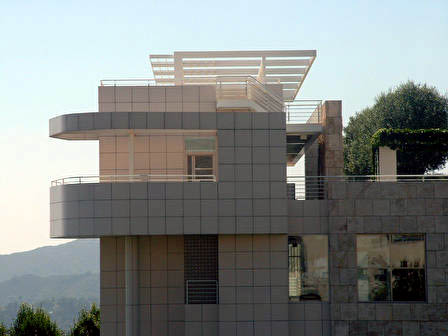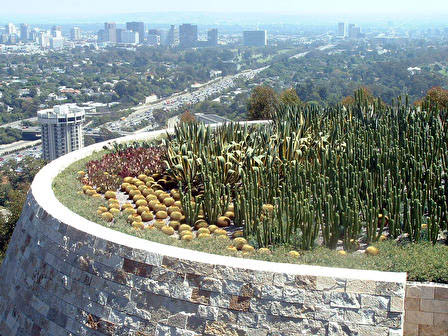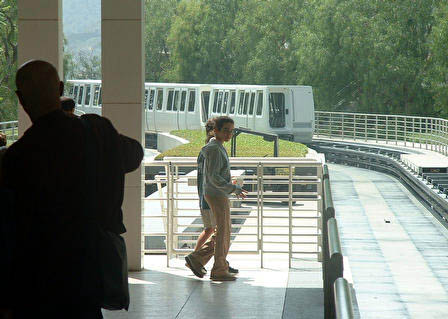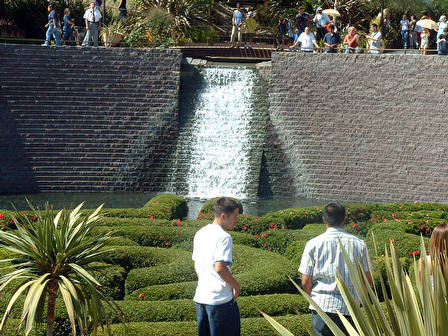|
Web Exclusives: Bonus Stories
October
9 , 2002: By Christopher Connell '71 It was happenstance that took us to the Getty Center in Los Angeles and the Guggenheim Museum in Bilbao eight days apart in late August. The California trip was planned. We were scouting colleges with our youngest. The appendectomy that our eldest underwent in Barcelona, where he works as a translator, was not. So we moved up plans to visit him in Spain. Matt recovered quickly enough to serve as both translator and navigator on our 350-mile journey over excellent highways to the coastal town. The Getty and the Guggenheim both opened in late 1997. Frank Gehry's titanium-clad masterpiece — a fantastic ocean-liner of a building, moored on the Nervion River in a Basque seaport — made the bigger splash. Bilbao, a gritty metropolis with half a million inhabitants, suddenly found itself the epicenter of the art tourism world, the recipient of the luckiest bit of fortune since Ringo Starr became the replacement drummer in an unknown Liverpool band. Richard Meier's gleaming latticework of buildings — with his signature white walls and travertine marble stones perched atop the foothills of the Santa Monica Mountains — hardly went unnoticed. Meier is the high priest of modernism. He was the youngest architect ever to win the Pritzker Prize (he was 49 when chosen in 1984, five years before Gehry received that laurel at 60). I must confess this actually was my second visit to the Getty. I spent 60 minutes there two autumns ago interviewing former Getty chief executive Harold Williams for an education project. Time was short that day; I did not enter a single gallery or even wander down the garden path. The dramatic setting recalled the futuristic lab in Woody Allen's 1973 spoof, Sleeper, (in reality, the I.M. Pei-designed home of the National Center for Atmospheric Research in Boulder, Colorado). The Getty tram was not even running that day. The stars were in the right alignment for my second visit. A brilliant blue sky, breezes, and the trams ferrying manageable crowds up the sinuous hillside, with the traffic whizzing below on the San Diego Freeway and UCLA's leafy Westwood campus in the distance. The Getty charges no admission, but requires reservations weekdays to park in the underground garage or in overflow lots off Sepulveda Boulevard. That serves to regulate the crowds. Some Angelinos pack lunches and ride the tram up simply to picnic in this beautiful setting. The Getty boasts a restaurant and two cafes. Diners can eat in the open air beneath the shelter of an overhang that looks like a giant piano (Advice for the hungry: Try the chicken sandwich with fig dressing). A path winds down to the Getty's garden maze. The buildings and galleries are all connected. Paintings are exhibited on the upper floors in sky-lit galleries. Beyond the southernmost gallery is a walk down to a cactus garden that commands a spectacular view of the City of Angels. The Getty has both paid staff and, fittingly for a great museum, volunteers to help visitors. It is a friendly, comfortable place, with benches in the galleries and soft chairs in the passageways — so comfortable that two obviously jet-lagged Japanese tourists who sat down near us nodded off in no time at all. You can learn about the Getty's permanent collection and exhibitions
at the Getty Web site. There
are old Master's, Impressionist paintings, illustrated manuscripts,
sculptures that span the centuries, and rooms devoted to the decorative
arts. I pass no judgment on these collections except to note that
visitors to both the Getty and the Guggenheim are drawn more by
the buildings than the treasures they house.
The Getty Center — the walls that blend aluminum, glass and travertine; the plazas; the exquisite gardens and landscaping, even the smooth, conductorless trams — worked for me in a way that no museum before ever had. For one delightful afternoon, architecture spoke to me. Now perhaps under the misapprehension that Frank Owen Gehry was, like my family, part of the Irish diaspora — actually he was born in Toronto to Polish immigrants named Goldberg and adopted the name Gehry as a young man in Los Angeles — I felt drawn to Bilbao from the moment I heard of plans for this titanium ship of dreams. Regis, the Jesuit high school I attended in New York was just five blocks from the Guggenheim mother ship, but that Frank Lloyd Wright creation in the round held no similar fascination for me. Our prospects for seeing this new Guggenheim brightened considerably when Matthew moved to Barcelona in April 2001. Eventually we would visit him — and that would be the chance. This was Matthew's second pilgrimage to Bilbao, and he knew precisely the streets to march us down so that we would turn a corner and — voila! — there would be the glimmering Guggenheim, all shiny silver curves and angles, with a verdant hillside as a backdrop. What I took to be a three-story topiary bear in front — perhaps a leftover mascot from the Barcelona Olympics? — was actually pop artist Jeff Koons's beloved Puppy sculpture — 43 feet of fresh flowers packed densely onto an invisible steel skeleton. It was previously perched in Germany and Sydney, Australia; Koons created a sibling for New York's Rockefeller Center two years ago. On a somber note, Basque terrorists — separatists is the politically correct term — killed a policeman who stopped them from bringing machine guns and grenades concealed in flower pots into the museum before the ceremonial opening in October 1997. There were demonstrations in Bilbao and Donasti (San Sebastian) during our visit to protest a judge's ruling banning the political arm of ETA, the terrorist group that has killed hundreds in its three-decade crusade to separate from Spain. Indeed, earlier on the day of our visit, police said they intercepted a van with 30 kilograms of dynamite. Still, security around the Guggenheim was either incredibly inconspicuous or not particularly heavy. Unlike the White House and much of the rest of official Washington, it is not barricaded. It does sit beside a large, unsightly, empty industrial pit that seems to have been left for the next phase of Bilbao's redevelopment. It is as if the Fairy Godmother gave Cinderella one glass slipper, not two. A busy avenue runs before the Guggenheim, and a bridge that bifurcates the tail end of the museum carries traffic to an unseen tunnel that actually runs through that pristine hillside in thedistance. Terrorism is the last thing on your mind when you fall under the spell of the Guggenheim. There were children running up and down the steps as we hurried to the entrance. When we emerged, we glimpsed a bride in her strapless gown holding the hand of a handsome groom by Koons's mammoth Puppy. I assumed they were actors posing for a commercial. But no, they were the genuine article, trailed by their wedding photographers, one shooting video, the other stills. I have no pictures to share from inside the Guggenheim. The perky security staff — all young and good-looking — carefully wrapped each tourist's camera in a plastic bag with holes so you could still carry the verboten device round your neck. There was a Kandinsky exhibit, and stunning photographs from four continents by the German film director Wim Wender ("Paris, Texas" and "Buena Vista Social Club") — fodder for a chapter in my future bestseller, Life Isn't Fair. A large, wonderful gallery held a selection of paintings by modern German artists. An exhibit of Paris art from 1900 to 1968, including several Giacometti sculptures, was in its final days. And there was a room with modern art, including a contraption that made a racket and rattled around every so often. There was no place to sit amid any of these Guggenheim galleries. Rather a harsher crowd control measure, I thought, than parking reservations. Here. too, the big show is outside. There is a spacious promenade along the river, and stairs up the intersecting bridge. Gilding their lily, the Guggenheim folks spew mists from fountains in the back of the museum. Gehry's creation is dramatic enough without that visual effect. Is the titanium rusting, as you may have heard? Perhaps a little here or there, but not enough that the man on the white horse would notice, to borrow one of my Irish mother's phrases. We actually were quicker to notice the dust bunnies on the sweeping white walls inside the Guggenheim. That cannot be blamed on the architect. A good whiskbroom with an extension handle would solve that problem. One hundred and forty pictures later, I left the Guggenheim a
happy man, thrilled with what Frank Gehry conjured up for us. I
loved this building from almost every angle; each change of cloud
and sunlight created new incarnations. Gehry is no Ringo Starr,
but Fortune clearly has smiled on him as well. Gehry is knocking
himself off in projects across America, from the rock 'n' roll museum
in Seattle to the Walt Disney Concert Hall in his hometown of Los
Angeles to a new wing of the Corcoran Gallery of Art in Washington.
That's all right. For me, there will always be Bilbao. Play it again,
Frank. Christopher Connell '71 is a writer in Falls Church, Virginia, who specializes in health, education and the arts. His e-mail is cconnell@cceditorial.com
|
||||||

